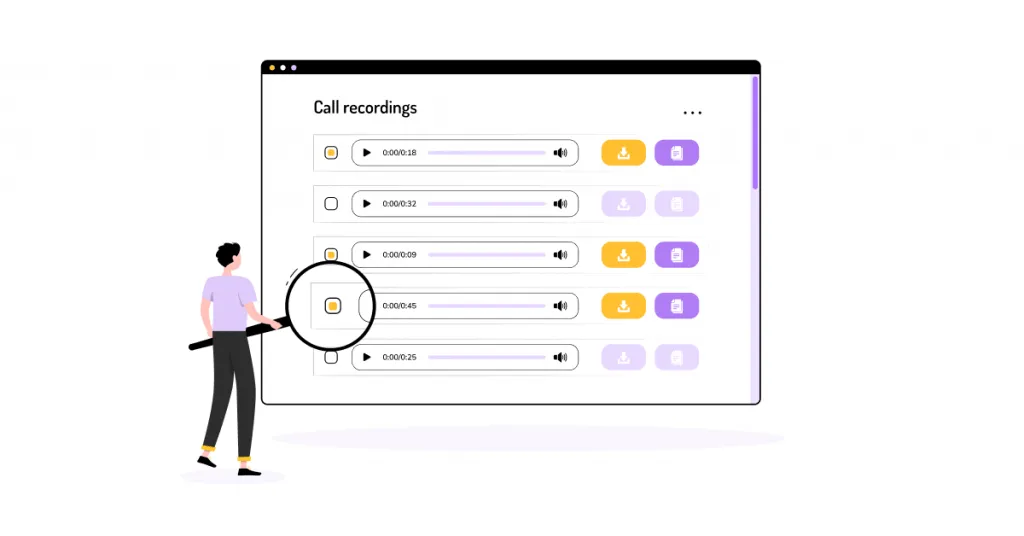Sales coaching isn’t just a nice-to-have—it’s a proven way to help your team win more deals. In fact, companies that invest in consistent sales coaching see up to a 32% increase in win rates (Gartner, 2024).
Yet many sales managers still treat coaching as an afterthought. This guide is here to change that. You’ll get real strategies, training methods, and tools that work in the field—not just in theory.
Coaching is often approached on an ad-hoc basis—a new rep asking a tenured one for advice, for instance—but this guide will help you establish a structured approach.
Whether you’re leading new reps or experienced sellers, this playbook will help you coach with confidence, improve performance, and drive real results. Let’s get started..
What Is Sales Coaching?

Sales coaching helps sales reps grow through regular guidance—not just once a quarter. It’s all about improving real deals in real time. According to Gartner, teams that use structured sales coaching see 32% higher win rates.
Great sales managers don’t just review results—they coach sales teams to build confidence, sharpen skills, and close more deals. To maximize impact, sales managers should focus their coaching efforts on the middle 60% of sales reps, not just the best or poorest performers.
However, many sales managers are typically promoted from the field without receiving the necessary training to coach effectively, which can limit their ability to drive team success.
Why Sales Professionals Need Coaching
Sales professionals face more pressure today than ever before. Shorter attention spans, longer sales cycles, and buyers who do their own research mean reps must constantly adapt. That’s where strong sales coaching makes the difference.
Additionally, effective sales coaching improves employee retention rates, ensuring your team remains motivated and engaged. It also maximizes your investment in sales training by reinforcing and applying learned skills in real-world scenarios.
So what do sales professionals really need?
They need more than product knowledge or basic scripts. What they need is real-time coaching, practical feedback, and tools that sharpen their skills in the moment—not weeks later.
According to a study by CSO Insights, salespeople who receive consistent coaching see win rates improve by up to 28%.
Here’s how you can support your sales professionals:
- Focus on their unique strengths. Each rep brings different skills. A one-size-fits-all approach doesn't work.
- Coach live deals. Don’t wait until the quarter ends. Use pipeline conversations and live role plays to coach deals as they happen.
- Make learning bite-sized. Sales professionals are busy. Micro-coaching—short, focused sessions—works better than long lectures.
- Use tech that helps, not hurts. Modern coaching tools let you track calls, highlight keywords, and spot habits that need fixing.
"The best sales professionals never stop learning. They crave feedback that helps them win, not just reports that tell them they didn’t." – Lori Richardson, sales strategist and founder of Score More Sales.
Proven Sales Coaching Strategies That Drive Results

1. Start with One-on-One Coaching Cadence
One-on-one coaching is a regular meeting between the sales manager and each rep. It's personal, focused, and helps tackle individual goals.
These coaching interactions provide insights that are difficult to achieve in group settings like team meetings, making them invaluable for addressing specific challenges and opportunities.
How to do it:
- Schedule 30 minutes weekly or biweekly with each sales rep.
- Review one live deal, not just past results.
- Ask simple questions like, “Where are you stuck?”
- Keep the tone friendly and supportive.
2. Use Role Plays Based on Real Scenarios
Role plays are practice sessions where reps simulate sales calls. This lets them try new techniques without real risks.
How to do it:
- Pick a real deal the sales professionals are working on.
- One plays the rep, one plays the buyer.
- Focus on objections, pricing talks, or discovery calls.
- Use tools like call recordings to guide the session.
3. Tie Coaching to Performance Metrics
This means aligning your coaching with data—not just gut feelings.
How to do it:
- Track key metrics like call volume, conversion rates, and pipeline health.
- Use sales coaching tools to spot trends or weaknesses.
- Set clear goals for each coaching session, like improving cold calling or shortening the sales cycle.
4. Leverage Call Recordings and Coaching Tools

Call recordings help you review actual sales conversations. Coaching tools make it easier to highlight strengths and improve weak spots.
Sales coaches who consistently analyze rep data and monitor activities are often able to identify issues before the reps themselves, allowing for timely and proactive guidance.
How to do it:
- Use software to record real sales calls.
- Play back the call with the sales rep and pause to give feedback.
- Highlight what went well and where to improve.
- Use sales coaching tools to tag good moments and save examples.
5. Build Confidence, Not Just Compliance
Coaching isn’t about checking boxes. It’s about helping reps believe in themselves and their skills.
How to do it:
- Recognize small wins in every session.
- Set clear, short-term goals for each coaching session.
- Celebrate improvement, not just results.
- Teach skills like cold calling, handling objections, or managing the sales cycle.
6. Make Coaching Personal, Not Generic
Each rep has different strengths, goals, and learning styles. Generic coaching doesn’t help much.
How to do it:
- Ask reps what they want to work on.
- Tailor coaching to the rep’s role, goals, or account type.
- Use examples from their own pipeline.
- Review business needs before every session.
7. Coach Around the Full Sales Process
Sales coaching shouldn’t just focus on closing deals. It should guide your sales team through every stage of the sales process—from prospecting to follow-up. This helps build long-term confidence and better decision-making.
How to do it:
- Break the sales process into clear steps: prospecting, qualifying, pitching, handling objections, closing, and follow-up.
- Coach sales reps on specific actions for each step.
- Use coaching sessions to role-play difficult parts like objection handling or negotiating price.
- Review recent sales calls to identify where the rep got stuck.
- Offer practical tools like checklists or playbooks for each stage.
Impact of Key Sales Coaching Strategies on Performance Metrics
Sales Coaching Programs That Actually Work (With Real Examples)

1. Winning by Design – For SaaS Sales Teams
Winning by Design is a data-backed sales coaching program built specifically for B2B SaaS companies. It focuses on revenue architecture and customer-centric selling.
Key Features:
- Blueprints for sales process design
- Role-based learning paths for sales reps, sales managers, and sales leaders
- Includes coaching sessions, deal reviews, and sales simulations
How to Use: Companies usually onboard teams over a 6–12 week cycle. Weekly modules are paired with live coaching.
Pricing: Starts around $1,000 per seat (custom pricing for large sales organizations)
G2 Rating: ★★★★☆ (4.6/5)
Pros:
- Tailored for SaaS
- Strong frameworks for sales cycle planning
- Focus on team-wide skills
Cons:
- Can be pricey for startups
- Needs internal follow-through after delivery
“Winning by Design helped us move from instinct-based selling to a repeatable system. Our reps are closing faster.” — VP of Sales, Series B SaaS Startup
2. Sales Gravy University – Real-Time Skills for Busy Reps
Led by Jeb Blount, Sales Gravy is built for sales professionals who want flexible, on-the-go learning and hands-on sales coaching.
Key Features:
- On-demand micro-courses for sales calls, prospecting, and cold calling
- Weekly live coaching sessions with certified sales coaches
- Focus on communication and sales skills
How to Use: You can sign up as an individual or enroll your entire sales team. Courses are mobile-friendly and self-paced.
Pricing: Starts at $49/month for individuals; team pricing available
G2 Rating: ★★★★☆ (4.5/5)
Pros:
- Affordable and flexible
- Great for entry-level sales reps
- Practical tips you can apply in your next call
Cons:
- Not ideal for senior sales managers
- Lacks deep customization for large teams
“It fits into our day without taking it over. Even 15 minutes a day helps our reps improve.” — Inside Sales Manager, Logistics Firm
3. Sandler Training – For Building a Coaching Culture

Sandler is one of the oldest and most respected names in sales coaching training. It focuses on creating long-term change and instilling a growth mindset across the sales organization.
Key Features:
- In-person or virtual classroom delivery
- Certifications for sales managers, coaches, and reps
- Emphasis on sales coaching conversations and manager accountability
How to Use: Sandler usually works best when implemented as part of a broader sales training or leadership development program.
Pricing: Mid-range to premium depending on format and customization
G2 Rating: ★★★★☆ (4.7/5)
Pros:
- Strong emphasis on behavior change
- Helps sales managers lead better coaching sessions
- Encourages reps to build confidence and own their outcomes
Cons:
- Can feel slow-paced for fast-moving startups
- Certification programs require time commitment
“Sandler didn’t just teach us how to sell—it taught us how to coach.” — Senior Manager, Enterprise Sales, USA
4. Chorus + Internal Coaching Program
Chorus is a sales coaching tool that helps sales managers review calls and give feedback. When paired with an internal sales coaching program, it helps sales teams track real conversations and coach based on real situations—not guesses.
Virtual sales coaching involves personalized guidance tailored to each participant's strengths and improvement areas, making tools like Chorus even more effective in delivering targeted feedback.
Key Features:
- Records and transcribes sales calls
- Automatically highlights moments like competitor mentions or pricing talk
- Allows sales leaders to leave time-stamped comments for sales reps
- Includes trend tracking for sales performance and team-wide improvement
How to Use: You can integrate Chorus with tools like Zoom or Salesforce. Use it to create a shared library of strong calls and weak ones. Set up weekly coaching sessions to review clips. This helps sales professionals learn faster and more accurately.
Pricing: Custom pricing. Usually part of a larger RevOps software package.
G2 Rating: ★★★★☆ (4.7/5)
Pros:
- Coaches in real time using real calls
- Saves managers hours of note-taking
- Great for hybrid or remote sales teams
Cons:
- Requires manager consistency
- Works best when your team already has a basic sales coaching training process
5. GrowthPlay – Focused on Behavioral Selling
GrowthPlay is a modern sales coaching program that helps reps and managers develop habits tied to buyer behavior. Instead of focusing on hard closing techniques, it sharpens your ability to listen, build trust, and solve real problems.
Key Features:
- Behavioral selling framework rooted in neuroscience
- Emphasizes coaching sales behavior, not just results
- Offers programs for both reps and sales coaches
- Includes diagnostic tools to identify performance gaps and coaching needs
How to Use: GrowthPlay starts with assessments for reps and sales managers. Then it offers coaching roadmaps based on each person’s style and strengths. You can customize the delivery: live, on-demand, or blended.
Pricing: Higher-end. Best for established sales organizations with defined sales process and business needs.
G2 Rating: ★★★★☆ (4.6/5)
Pros:
- Focuses on long-term growth and habit change
- Personalized for each sales rep
- Helps build confidence in selling naturally
Cons:
- May be too advanced for brand-new sales teams
- Takes time to fully implement
“GrowthPlay helped us coach around buyer psychology—not just features. That changed everything.” — Director of Sales, Healthcare SaaS, Canada
Sales Coaching Training Methods

1. Call Shadowing with Feedback Loops
Call shadowing is when a sales manager or sales coach listens to a rep’s call live or via recording. After the call, they offer feedback. A “feedback loop” just means repeating this process regularly.
How to do it:
- Pick a real customer call or sales demo.
- Have your sales coach observe without interrupting.
- After the call, give feedback on tone, questions, and timing.
- Highlight what went well and one or two things to improve.
- Create a shared doc or use sales coaching tools to track progress.
2. Micro-Coaching Sessions (10–15 Minutes)
Micro-coaching is short, focused coaching sessions. It’s perfect when your sales managers are busy and your sales professionals need quick help—not a lecture.
How to do it:
- Schedule 10–15 minutes after a sales call or during team check-ins.
- Ask the rep to reflect first: “What went well? What would you change?”
- Focus on one small area like cold calling, handling objections, or asking better questions.
- Tie the <hr>conversation to a real deal or current goal.
3. Video Role Plays & Peer Reviews
This method helps your reps learn by doing—and by watching each other. Sales reps record themselves in mock sales situations. Then peers or managers give feedback.
How to do it:
- Assign a specific scenario like handling objections or doing a product demo.
- Reps record short role play videos using tools like Loom or their phones.
- Pair them with another rep or sales coach for review.
- Use a checklist to evaluate tone, question flow, and clarity.
- Share strong examples with the whole team.
4. Skill-Focused Coaching Tracks

Instead of broad sales training, these are short coaching plans focused on one core skill at a time—like prospecting, cold calling, or improving sales performance.
How to do it:
- Start by identifying skill gaps using CRM data or call recordings.
- Build a weekly plan around one focus area (e.g., building trust, asking better questions).
- Include daily practice, short content, and quick peer check-ins.
- End each track with a live coaching session and a feedback summary.
- Track progress using a simple performance log or coaching program dashboard.
5. Live Coaching During Pipeline Reviews
Pipeline reviews are meetings where you go through open deals. Turning them into coaching moments can boost sales performance and improve how your reps think through challenges.
How to do it:
- Meet weekly or biweekly to review the team’s pipeline.
- Ask your sales reps to walk through key deals.
- As they talk, coach them on next steps, risk factors, and messaging.
- Tie the advice to specific outcomes like better follow-ups or closing deals faster.
- Track progress on each deal with short written notes or in your CRM.
6. AI-Powered Feedback Tools
AI tools listen to your sales calls and give automatic suggestions. They tell you what’s working—and what’s not—based on patterns across thousands of conversations.
How to do it:
- Use tools like Gong or Chorus to track sales conversations.
- Let AI highlight weak spots like talking too much or skipping discovery questions.
- Review these insights in sales coaching sessions with your reps.
- Use it to personalize coaching for each sales professional.
- Add the feedback to your internal training materials.
7. Self-Coaching with Replays & Scorecards
Self-coaching is when sales professionals review their own sales calls and use scorecards to rate how they did. It helps reps reflect, build awareness, and catch patterns.
How to Do It:
- After every important sales call, have the rep watch or listen to the replay.
- Use a simple scorecard with items like: Did you ask enough questions? Did you handle objections?
- Encourage reps to write one strength and one improvement.
- Let them share wins during team meetings or coaching huddles.
- Managers can review the same scorecards to track progress.
Sales Coaching for Sales Team Leaders: How to Create a Scalable Coaching Culture

- Set a Coaching Standard—Then Document It: Don’t assume your managers or sales coaches know what good coaching looks like. Define it. Create a short coaching guide or checklist for your team. Include key areas like sales skills, deal reviews, and follow-up habits. Use it to keep everyone aligned, especially across remote teams.
- Coach the Coaches: Your sales managers need coaching too. Run monthly sessions where you coach them on coaching style and structure. Role play common sales conversations and give feedback.
- Integrate Coaching into Daily Routines: Coaching doesn’t need to be formal. Make it part of your daily workflow. Add 10-minute coaching check-ins to pipeline or stand-up meetings. Review one recorded call or sales coaching conversation each day.
- Measure the Right Coaching Metrics: Don't only measure hours spent coaching. Focus on impact. Track improvements in sales performance per rep. Use feedback scores or follow up sessions to see progress. Add simple rating options to your training program tools. Sales management must align coaching goals with broader business outcomes.
- Create Peer Coaching Pods: Some of your best coaching comes from peers. Group reps into coaching pods of 3–4 people. Let them watch each other’s role plays and give feedback. This builds accountability and communication skills too.
- Use the Right Tools to Scale: Use tools that help, not slow you down. Try tools like Chorus, Gong, or even Google Docs for shared feedback. Track keywords, response time, and question types automatically.
- Celebrate Coaching Wins Publicly: Coaching works best when it’s visible. Share “coaching wins” weekly on Slack or in team huddles. Highlight reps who’ve improved a key skill or hit a sales goal.
How to Customize Coaching by Business Needs and Account Type

1. Segment Accounts First—Then Tailor Your Coaching
Start by sorting your accounts into categories like SMB, mid-market, and enterprise.
- Each group has different expectations, budgets, and sales cycles.
- For SMBs, coach reps on speed and clarity.
- For enterprise deals, teach strategic questions and multi-touch follow-ups.
2. Align Coaching with Revenue Goals
Your sales coaching program should support the company’s revenue strategy—not work in isolation.
- If your goal is to increase revenue from existing clients, coach around cross selling and account expansion.
- If your goal is net new business, shift focus to prospecting and pitch quality.
- Use these sessions to teach reps how to meet both short- and long-term sales goals.
3. Use Role-Specific Scenarios in Coaching Sessions
Don’t give your account executives the same training as SDRs.
- For SDRs, coach on cold outreach and video prospecting.
- For AEs, focus on presentations, demos, and navigating long sales cycles.
- Let reps practice using role plays that match their real-life job.
4. Teach Based on Sales Cycle Length

Some reps close deals in days. Others take months.
- For shorter cycles, coach around speed, quick objections, and fast follow-up.
- For longer cycles, coach on nurturing, customer relationships, and staying top of mind.
- Review sales coaching conversations regularly to adapt your approach.
5. Review Industry Trends and Buyer Behavior Together
Your buyers are changing. So should your coaching.
- Set up monthly “buyer pulse” meetings with your sales team.
- Discuss industry shifts, new competitor messaging, and what buyers are saying on calls.
- Share insights from professional development webinars, LinkedIn polls, or customer interviews.
6. Use CRM Data to Spot Coaching Opportunities by Account
CRM tools aren’t just for tracking. They’re gold mines for sales coaching opportunities.
- Look for stalled deals, low call-to-demo ratios, or patterns in close-loss reasons.
- Use tags like “new business” or “upsell” to guide coaching on selling and strategy.
- Spot where coaching is needed most—especially by account type or vertical.
7. Document & Share Account-Type Playbooks
Don’t make reps guess. Help them succeed faster with clear, useful content.
- Create short playbooks by account type—SaaS, retail, enterprise, etc.
- Include talk tracks, effective sales training examples, and questions that worked.
- Add relevant learning materials like one-pagers or short video walkthroughs.
Practical Sales Coaching Tips for Your Day-to-Day Conversations

- Start With a Question, Not an Answer: Instead of jumping in with a solution, ask a thoughtful question. For example: “What made you pause before asking for the close?” This encourages reflection, builds sales skills, and keeps coaching collaborative.
- Coach in the Moment—Don’t Wait for the 1:1: Don’t wait for a scheduled sit-down. Catch learning moments when they happen. Right after a call or meeting is when feedback feels most relevant.
- Use Call Snippets Instead of Full Call Reviews: Instead of replaying long calls, grab 30-second snippets to highlight what went well or what can improve. This saves time and keeps coaching sharp and focused. It’s one of the easiest sales coaching techniques to adopt.
- Tie Coaching to Active Deals: Use sales coaching to directly impact live deals. Ask reps: “What’s your next move with this account?” Linking coaching to sales strategy keeps things practical and increases urgency.
- End With a Mini Action Plan: Wrap up every coaching moment with a clear takeaway. Even something small like “Try rephrasing your close this way on the next call” creates progress.
- Track Small Wins & Call Them Out Publicly: Celebrate coaching wins—especially in team huddles or Slack. When team members see progress recognized, they’re more likely to lean into coaching.
This builds confidence and boosts team morale.
Common Mistakes Most Sales Managers Make in Sales Coaching

1. Treating Coaching Like a Performance Review
- The Problem: Many most sales managers treat coaching like a formal review. It feels stiff, judgmental, and disconnected.
- The Fix: Sales coaching should feel like a conversation, not a scorecard. Focus on growth, not just gaps. Use your training program to create real-time learning—not once-a-quarter check-ins.
2. Focusing Only on Weaknesses
- The Problem: If you only coach on what’s wrong, team members may shut down or lose confidence.
- The Fix: Call out what's working, too. Build on skills that are already strong. Reinforce wins. Celebrate smart decisions. This improves morale and sales performance.
3. Coaching Only When There’s a Problem
- The Problem: If you only show up when something breaks, sales reps start to avoid feedback.
- The Fix: Make coaching part of your everyday rhythm. Add bite-sized sessions between calls. Even five minutes of sales coaching training can help coach sellers toward better habits.
4. Using Generic Advice That Doesn’t Match the Deal

- The Problem: Telling everyone the same tip? Doesn’t work. Every account is different. Every sales process has nuances.
- The Fix: Use relevant content and deal-specific CRM data to coach smarter. Adjust your advice based on business needs, not just gut feeling.
5. Ignoring Data from Sales Coaching Tools
- Problem: Many managers coach from instinct, not insight.
- Solution: Great sales coaching needs data. If you're not using sales coaching tools, you’re flying blind. Tools like Gong or Chorus can show real examples of sales conversations and highlight weak spots or missed cues. Use call recordings to track progress. Compare top sales reps and core performers. Look at deal outcomes tied to coaching.
6. Overloading Reps With Feedback
- Problem: Giving too much advice at once confuses people.
- Solution: Focus on one or two skills at a time. Let reps work on it before piling on more. Reps—especially most salespeople—don’t improve from feedback overload. Prioritize what matters most for each account type. Tie feedback to real deals and sales strategy. Celebrate progress, not perfection.
7. Failing to Follow Up
- Problem: A coaching session without follow-up is a waste.
- Solution: Sales coaching should be a loop. Revisit action plans, ask what worked, and check progress. Schedule 10-minute follow up sessions. Use your training program to track growth. Keep it friendly and low-pressure.
8. Assuming Top Performers Don’t Need Coaching
- Problem: Some managers skip coaching for top reps.
- Solution: Your sales success depends on everyone growing—even stars. In fact, coaching sales to high performers can drive innovation. Review what works and document it for others. Ask your stars to coach team members. Focus on new skills and cross-training.
Sales coaching is no longer optional—it's a competitive advantage. When done right, it builds confidence, sharpens selling skills, and drives measurable growth. Whether you're guiding new reps or top performers, the right coaching program can improve performance, increase revenue, and boost win rates. Effective sales coaching ensures that no team members slip through the cracks during training, fostering a culture of continuous improvement. Now’s the time to coach smarter and lead stronger.





.jpg)

.jpg)
